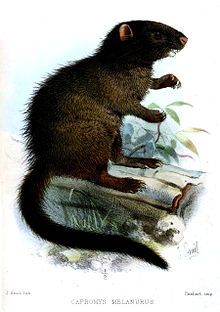Mesocapromys
Appearance
| Mesocapromys | |
|---|---|

| |
| Black-tailed hutia (Mesocapromys melanurus) | |
| Scientific classification | |
| Domain: | Eukaryota |
| Kingdom: | Animalia |
| Phylum: | Chordata |
| Class: | Mammalia |
| Order: | Rodentia |
| Family: | Echimyidae |
| Subfamily: | Capromyinae |
| Tribe: | Capromyini |
| Genus: | Mesocapromys Varona, 1970 |
| Type species | |
| Capromys(Mesocapromys) auritus | |
| Species | |
|
Mesocapromys angelcabrerai | |
| Synonyms | |
|
Paracapromys Kratochvíl, Rodriguez, & Barus, 1978 | |
Mesocapromys is a genus of rodent in the subfamily Capromyinae.[1] The genus is restricted to Cuba and associated islands.
Systematics
[edit]Mesocapromys contains the five following species:[1]
- Cabrera's hutia (Mesocapromys angelcabrerai)
- Eared hutia (Mesocapromys auritus)
- Black-tailed hutia (Mesocapromys melanurus)
- Dwarf hutia (Mesocapromys nana)
- San Felipe hutia (Mesocapromys sanfelipensis)
Phylogeny
[edit]Within Capromyidae, the closest relative of Mesocapromys is the genus Mysateles. Both genera are the sister group to Capromys, and then Geocapromys is a more distant genus. In turn, these four genera belong to the tribe Capromyini, and are the sister group to Plagiodontia.
| Genus-level cladogram of the Capromyidae with their relationship to Carterodon and Euryzygomatomyinae. | ||
|
| ||
| The cladogram has been reconstructed from mitochondrial and nuclear DNA characters.[2][3][4][5][6][7] |
References
[edit]- ^ a b Woods, C.A.; Kilpatrick, C.W. (2005). "Genus Mesocapromys". In Wilson, D.E.; Reeder, D.M (eds.). Mammal Species of the World: A Taxonomic and Geographic Reference (3rd ed.). Johns Hopkins University Press. pp. 1538–1600. ISBN 978-0-8018-8221-0. OCLC 62265494.
- ^ Galewski, Thomas; Mauffrey, Jean-François; Leite, Yuri L. R.; Patton, James L.; Douzery, Emmanuel J. P. (2005). "Ecomorphological diversification among South American spiny rats (Rodentia; Echimyidae): a phylogenetic and chronological approach". Molecular Phylogenetics and Evolution. 34 (3): 601–615. doi:10.1016/j.ympev.2004.11.015. PMID 15683932.
- ^ Upham, Nathan S.; Patterson, Bruce D. (2012). "Diversification and biogeography of the Neotropical caviomorph lineage Octodontoidea (Rodentia: Hystricognathi)". Molecular Phylogenetics and Evolution. 63 (2): 417–429. doi:10.1016/j.ympev.2012.01.020. PMID 22327013.
- ^ Fabre, Pierre-Henri; Galewski, Thomas; Tilak, Marie-ka; Douzery, Emmanuel J. P. (2013-03-01). "Diversification of South American spiny rats (Echimyidae): a multigene phylogenetic approach". Zoologica Scripta. 42 (2): 117–134. doi:10.1111/j.1463-6409.2012.00572.x. ISSN 1463-6409.
- ^ Fabre, Pierre-Henri; Vilstrup, Julia T.; Raghavan, Maanasa; Der Sarkissian, Clio; Willerslev, Eske; Douzery, Emmanuel J. P.; Orlando, Ludovic (2014-07-01). "Rodents of the Caribbean: origin and diversification of hutias unravelled by next-generation museomics". Biology Letters. 10 (7): 20140266. doi:10.1098/rsbl.2014.0266. ISSN 1744-9561. PMC 4126619. PMID 25115033.
- ^ Upham, Nathan S.; Patterson, Bruce D. (2015). "Evolution of Caviomorph rodents: a complete phylogeny and timetree for living genera". In Vassallo, Aldo Ivan; Antenucci, Daniel (eds.). Biology of caviomorph rodents: diversity and evolution. Buenos Aires: SAREM Series A, Mammalogical Research — Sociedad Argentina para el Estudio de los Mamíferos. pp. 63–120.
- ^ Fabre, Pierre-Henri; Upham, Nathan S.; Emmons, Louise H.; Justy, Fabienne; Leite, Yuri L. R.; Loss, Ana Carolina; Orlando, Ludovic; Tilak, Marie-Ka; Patterson, Bruce D.; Douzery, Emmanuel J. P. (2017-03-01). "Mitogenomic Phylogeny, Diversification, and Biogeography of South American Spiny Rats". Molecular Biology and Evolution. 34 (3): 613–633. doi:10.1093/molbev/msw261. ISSN 0737-4038. PMID 28025278.
